If you’ve ever seen a drag queen performance — either in person at your local club or on “RuPaul’s Drag Race” — you’ve likely admired their charisma, uniqueness, nerve and talent.
But one thing you might not have admired? Their bank account.
Being a drag queen — even being a famous drag queen — may not pay the bills. And there are a lot of bills to pay.
“People do drag because people love drag,” Indianapolis-based drag king Damien Belmont said. “Nobody's getting rich doing drag. That's the unfortunate reality, but it's reality all the same.”
What is the cost?
Like any other kind of artist, the costs associated with being a drag queen may seem minimal if you’re not in the biz. But for those working regularly, there are huge costs associated with it.
We need your help to stay independent
Denver-based Jessica L'Whor, a full-time drag queen and performer, breaks down the makeup costs:
- Makeup: Between $50 – $100 every 2-3 months
- Skincare products: About $50 per month
- Costume commissions: Sporadic, but averages between $625 and $1,250 per month
- Wigs: Each wig costs between $20 and $700
- Wig restyling: Between $50 and $200 depending on various factors
- Gas: Varies depending on how far you have to travel for a gig
“It all adds up,” L'Whor said.
What’s even more surprising is how much — or perhaps more accurately, how little — drag queens make per gig. On average, L'Whor says that clubs pay between $75 and $200 per gig. And while patrons can tip, those amounts also vary. If it’s a slow night or people are feeling frugal, tips can be minimal. That’s another major reason why many drag queens only rely on their art as a side hustle.
“I’d say 25% of drag queens make a full-time living,” said drag queen Dixie Krystals.
Belmont said he doesn’t know any drag queen or king who makes a living based solely on their performances.
“In fact, most of us are lucky if we kind of break even when it comes to expenses,” Belmont said. “It gets really expensive really quickly, especially if you’re not resourceful.”
What’s hurting drag queens?
Between 2002 and 2023, more than 45% of gay clubs closed in the U.S. These clubs are the lifeblood for drag queens — every time a gay or queer club or bar closes, queens inevitably lose out.
High food prices and housing costs mean consumers have less to spend at bars. That means less money for tickets to drag shows, for tipping queens and for drinks.
"It gets really expensive really quickly, especially if you’re not resourceful"
Also, “going out” culture has changed. Gen Z has been hailed as the first generation to drink more responsibly, but spending less money on alcohol hurts the nightlife business. The fewer people there are at a show, the less money is spent on the queens.
The cost of RuPaul’s “Drag Race"
OK, so being a local drag queen doesn’t pay much. But surely being a drag queen and a TV star must pay more, right? Not necessarily.
Since 2009, “RuPaul’s Drag Race” has been hailed as one of the best reality shows around. It’s also been a proving ground for drag queens not only in America, but all over the world.
However, with the 10th season of “RuPaul's Drag Race All Stars” airing now, some critics are noticing that "Drag Race" alumni aren't as profitable as they used to be.
Many queens spend thousands of dollars on their outfits just to appear on the show. And if they aren’t a winner or a fan favorite, they may “never earn that money back, leaving them financially devastated," according to one queen.
Several have said they’re not pulling in as much as they expected, even after appearing on the show and progressing through the various rounds. Season 15 contestant Salina EsTitties said many “Drag Race” alumni are not raking it in, especially not after recent economic changes.
These struggles have been coming to a head for years. Ever since “Drag Race” became a mainstay, queens have been spending more money, often taking out huge loans to cover what their savings can’t. Most recently, season 17 contestant Lexi Love said she took out a second mortgage to pay for her outfits for the show.
So whether you’re a local drag queen performing at a club a few times a month or a reality TV star, the cost of drag weighs on everyone.


